Can you tell us a bit about your family history and how you got started in the Armenian ceramics business?
Mr. George Sandrouni: My father became an orphan when he was 9 years old and began to work for his grandmother, he taught me how to work hard. The beautiful work of the artist David Ohannessian, who established the Armenian ceramic craft industry in Jerusalem, was an inspiration for my 2 brothers and I, loved his work, colors and pieces. In 1970, we began to see a business gap between Armenian ceramics mass production and hand-painted ceramics, so in 1983 we created a gallery for the Armenian Art & Craft Center and since then, our family has been creating handcrafted ceramics in the Old City of Jerusalem. Today, in my own style, colors, and pieces I have my own ceramic workshop in the New Gate, Old City of Jerusalem.
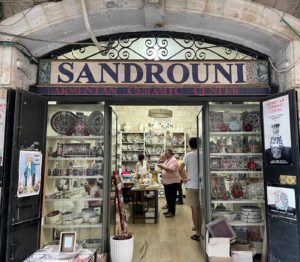
Sandrouni’s shop at the Old City, Jerusalem
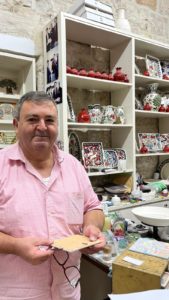
George Sandrouni
What makes Armenian ceramics so special and distinctive compared to other ceramic traditions?
George: Armenian ceramics are known for their vibrant colors and intricate designs. We use traditional techniques of glazing and painting that have been passed down through generations. Each piece is unique and handmade, giving it a special artistic and cultural value, no two pieces look alike. The motifs often include flowers, birds, and geometric elements, all with deep symbolic meaning.
How has the city of Jerusalem influenced your family’s art and ceramic production?
George: Not only is Jerusalem a city rich in history and cultural diversity, but the Holy Land as a whole has had a significant impact on our work. Many motifs, subjects, and mosaic are a huge inspiration. Things like Tabgha, an Armenian mosaic of the birds of the 6th century; and the Palace Mosaic; in fact the entire land is inspiring. The mix of cultures and religions constantly inspires us, and we see our art as a bridge between these different communities.
Can you describe the process of creating an Armenian ceramic piece in your workshop?
George: We buy our pottery from suppliers, like an artist who does not make his canvases. First, we paint with a black pencil the drawing and design. Then, each piece is hand-painted with detailed designs and full colors. After painting, we apply a clear glaze and cook it in a kiln at high temperatures, to provide the shiny gloss of the piece. This process can take several weeks, depending on the size and complexity of the piece.
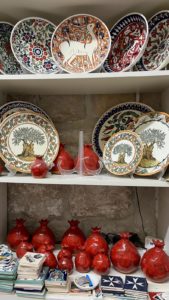
Armenian ceramic products in the shop
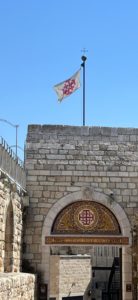
Entrance of the Custody of the Holy Land, Old City Jerusalem
What is the most memorable or significant ceramic piece you have created and why?
George: One of the most memorable pieces I have created is a large frame depicting the entrance of the Franciscan Monastery, the main gate in the Old City of Jerusalem that says, “God bless and protect you”. This work combines a lot of patience, negotiations between people from different cultures and countries that have coexisted in the Franciscan convent. It was a challenging project between the designer and the producer but a very rewarding project, as it symbolizes the entrance of the Franciscan community, their unity and peace for all the world, when you go into the Convent of the Custody of the Holy Land.
Finally, what do you hope for the future of Armenian ceramics in Jerusalem and for your family?
To the young people I would like to say: get away from technology and create your own art with your hands, basic art and enjoy your creative abilities. Do not think about the money but about enjoying your art and service to give beauty to others. There will always be customers looking for genuine Armenian ceramic work in the world, from Jerusalem, painted by hand.
Our pieces try to combine elements of beauty from different cultures and religions that have coexisted in the city over the centuries. It is a challenging but very rewarding project, as it symbolizes the unity, beauty and peace we all seek in our hearts.
Armenian ceramics continue to thrive in Jerusalem and our traditions remain appreciated by all generations. I want our family to remain a pillar of this beautiful tradition. Teaching about and sharing our colorful ceramics continues to be a symbol of the rich cultural heritage, and peaceful coexistence in Jerusalem. Hope for beautiful art and good hearts will never end!
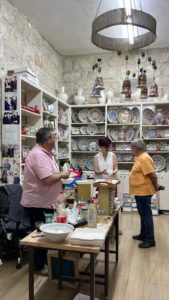
George and his wife Dorin with a customer
